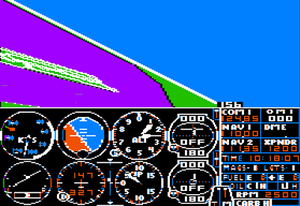When this thread lasts long enough we will end up with "It started with version FS -2"



Cheers,
Huub
Since you asked....
Second generation (FS2 for Apple II, Commodore 64 & Atari 800)
<dl><dd>- 1983 for the Apple II</dd><dd>- 1984 for the
Commodore 64 &
Atari 800</dd></dl>


A screenshot from
Flight Simulator II, showing the southern end of
Meigs Field in
Chicago.
With the release of a superior Flight Simulator for the PC,
subLOGIC felt some pressure from their customers to backport these improvements to the original platforms, thus prompting subLOGIC to release a new version called
Flight Simulator 2 version 1 for non-IBM compatibles. This version, like the
Microsoft release, did away with wireframe graphics for solid colors, and featured real-world scenery (although limited to a few areas in the United States).
It was also this version (FS II) that introduced the whole concept of simulator add-ons, although not in the form it is today, as subLOGIC also included functionality to load additional scenery from floppy disks, thus making it possible for a user to virtually fly in his or her own backyard.
That was just for Huub's bnefit

Now, for the whole scoop:
http://en.wikipedia.org/wiki/History_of_Microsoft_Flight_Simulator
More to the OP's question:
"With its many options and add-ons, yet still relatively tight "in program" integration and overall ease of use, the FS4 suite of programs presented a type of VR Toolkit for users with a flight simulator slant. While complex in some aspects, FS4 environment building options (including scenery and aircraft design) would provide an unsurpassed access to these activities for average users; an option, which in later versions of FS, was much less available and increasingly complex."
If you don't like reading,here is the video ( but with lots less information)
http://www.youtube.com/watch?v=ICb9ZXiD3q4
BTW, my 'history' started with subLogic's FS1 (TRS80), sL Generation 3 (Mac), MSFS 1.0. 2.0, 4, 5.0, 5.1 and then I gave up until FS9, FSX (often under duress)


